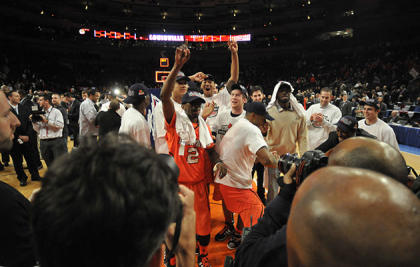Big East's tumultuous run doomed from the get-go
From the moment it was born, the Big East was a dead league walking. Even through its best years, the whole thing felt like an arranged marriage made for network boardrooms. Now that it is ending, the biggest surprise isn't that the Big East has fallen apart for good, but rather that it lasted for 34 years.
On Tuesday, the conference begins its final tournament in its current form. Then again, it's hard to know what form that is exactly. The Big East has been many things in its existence – a union of small Northeastern basketball schools, a football league, a haphazard hybrid of both. Each reinvention was another attempt to resuscitate a league that was never going to be saved. Its demise was only a matter of time.

The problem with the Big East is that it started as an experiment. Could the best basketball schools from Boston to Washington form a league based on television money? For a time, they could. As college basketball blossomed and coaches became superstars themselves, the Big East delivered. It took John Thompson, Jim Boeheim and Lou Carnesecca and made them larger than life. It brought eternal fame to an angry, rumpled Rollie Massimino and gave a home to the fury of a feisty, ignored New Englander named Jim Calhoun.
But experimental college sports leagues rarely last long, and simply having the biggest coaches and best tournament wasn't enough to keep the Big East breathing. Aside from basketball and money, there was little to hold the conference together. Where the most important leagues are usually built around state schools, the Big East tried to mix small Catholic colleges with big state universities. It blended urban with rural; basketball schools with football powers. Eventually 21 schools came to call themselves Big East in something. No league can survive turmoil like that.
And yet, even in the early years, when basketball was enough to keep the Big East thriving, the signs of its ultimate demise were never far away.
"Very few schools cared about the conference as a whole," former Connecticut president Harry Hartley said late last week. "When we would go to the presidents meetings there was a big rivalry between the Catholic school presidents."
[Also: Wins mean very different things for bluegrass rivals UK, Louisville]
For much of the early 1990s, Hartley worked to keep a fractured league from breaking apart. As the president of a founding member that was a state school but one still without a Division I-A football program, he was a buffer between the basketball-only interests of places like Seton Hall and Providence while understanding the broader concerns of Syracuse and Pittsburgh.
And with each year the gap grew wider. The small Catholic schools without big football programs resented the Big East's football league, invented in the early 1990s as a means of survival in a world where football was beginning to drive every decision in every big conference. But even they had divergent interests. What did Georgetown, as a small almost-Ivy League school, really have in common with Seton Hall in the hardscrabble suburbs of New York City? Or St. John's? Or Boston College with a football team that went to big bowls and produced a Heisman Trophy winner?
When the league invited Notre Dame as a non-football school in the early 1990s, Hartley said the Catholic colleges had a near-mutiny.
"They threatened to just walk out," Hartley said by phone from his Palm Beach, Fla., home.
[Also: IU's Victor Oladipo succeeds despite lack of support from father]
One Catholic school demanded the league adopt a policy prohibiting the addition of any more schools, he said.

Hartley thinks the only reason the league was able to stay together and thrive in the first 12 years after its founding in 1979 was the leadership of its first commissioner, Dave Gavitt. A successful basketball coach at Providence through the 1970s, Gavitt loomed large over the conference, cutting big television deals and squelching disputes among the schools. When Gavitt left in 1990, the force of his personality disappeared too. Not that it probably mattered. Eventually even Gavitt wouldn't have been able to hold the diverse interests together.
"The Big East after Gavittt was a bunch of fiefdoms and very selfish interests as opposed to a cohesive conference that was healthy," Hartley said. "We shifted. It moved from being an athletic directors' conference to a presidents' conference. The feeling was the schools were more important than the athletics."
Over the years, Hartley said he made suggestions he thought would salvage the league. For instance, he wondered why the league kept insisting on keeping its offices in Providence rather than move to New York – a small but important sign that the conference understood how big it had become. The presidents, he said, rejected the notion.
[Also: How Indiana began wearing its trademark candy-striped warmup pants]
Now the Big East is done. Years ago, Boston College left for the ACC, which is where Syracuse, Louisville and Pitt are headed. The Catholic schools are starting their own league, leaving behind leftover football schools like UConn and South Florida. Perhaps fitting for a league built on television money, the departing Catholic colleges bought the Big East name for their new conference and will re-create the old Big East tournament by keeping it in Madison Square Garden.
It might even be as good as the old tournament. But it won't be the same.
It won't be the real Big East – the league that was born to die.
Memorable Moments on Yahoo! Sports:
Other popular content on Yahoo! Sports:
• Georgetown beats Syracuse, earns Big East tourney's top seed
• Ravens might release WR Anquan Boldin if he doesn't accept pay cut
• Canada-Mexico brawl gives WBC its memorable moment
• Watch: Tiger Woods drive ends up lodged in palm tree